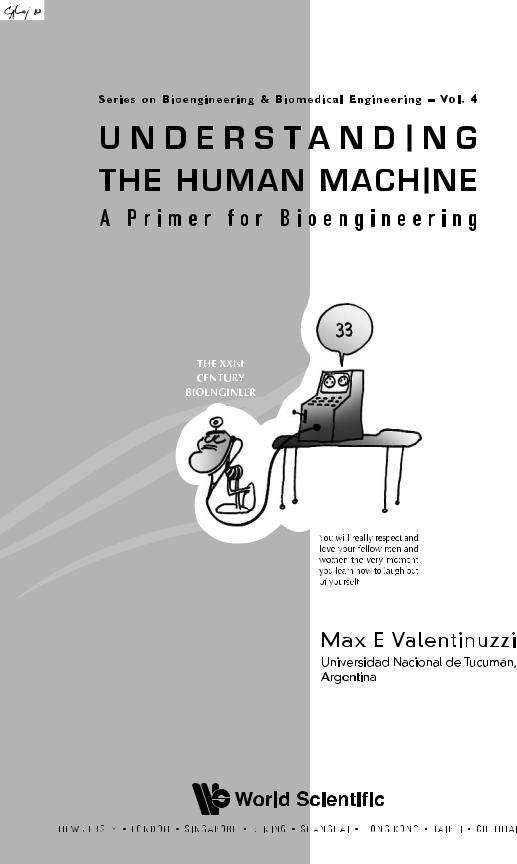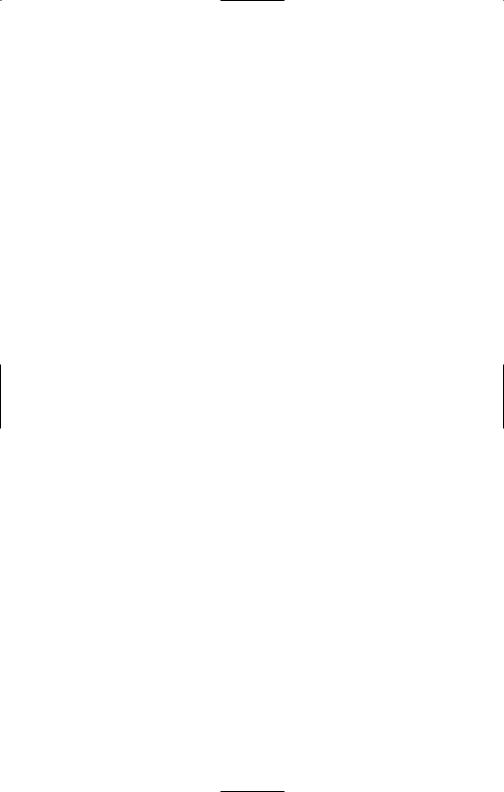
Understanding the Human Machine - A Primer for Bioengineering - Max E. Valentinuzzi
.pdf



Published by
World Scientific Publishing Co. Pte. Ltd.
5 Toh Tuck Link, Singapore 596224
USA office: 27 Warren Street, Suite 401–402, Hackensack, NJ 07601
UK office: 57 Shelton Street, Covent Garden, London WC2H 9HE
British Library Cataloguing-in-Publication Data
A catalogue record for this book is available from the British Library.
Cover design: Copyright Comic by Caloi, 1983.
Carlos Loiseau, Caloi, is a well-reputed and internationally-known graphic humorist (www.caloi.com.ar). In 1973, he created Clemente, a comic strip character with a keen human perception. Clemente met Carmelo J. Felice (contributor to this book), in Bariloche, Argentina, in 1983, and immediately became a bioengineer. Ever since, he has presided our Lab from a frame hanging on one wall of the author’s office. Now, he is kind enough to joyfully lead you into this textbook, with his courtesy and wit, as the paradigmatic XXIst Century Bioengineer.
UNDERSTANDING THE HUMAN MACHINE
A Primer for Bioengineering
Series on Biomaterials and Bioengineering — Vol. 4
Copyright © 2004 by World Scientific Publishing Co. Pte. Ltd.
All rights reserved. This book, or parts thereof, may not be reproduced in any form or by any means, electronic or mechanical, including photocopying, recording or any information storage and retrieval system now known or to be invented, without written permission from the Publisher.
For photocopying of material in this volume, please pay a copying fee through the Copyright Clearance Center, Inc., 222 Rosewood Drive, Danvers, MA 01923, USA. In this case permission to photocopy is not required from the publisher.
ISBN 981-238-930-X
Printed in Singapore.
Dedication
To my paternal Grandfather, Máximo I, carpenter, for his everlasting kindness and generosity;
To my paternal Grandmother, Clementina, laundrywoman,
for the unrelenting concern aimed at her children’s education;
To my maternal Grandmother, Concepción, seamstress, who could not read and write,
for her sweetness and constant love.
Their words, acts, faces, are still vivid in my memory.
My maternal Grandfather, Vicente, tailor,
died of lung cancer when I was only a few months old.
They gave me my parents, Emma and Máximo II;
my mother had only fourth grade, was raised in poverty and offered everything she could for the education of her children;
my father, who was also raised in poverty, and after a life spent with medicine and biophysics, as physician first and later on as teacher and researcher, said in his farewell words to his last students at the Chicago College of Osteopathic Medicine, in Chicago, on May 3, 1972, coincidentally and exactly 30 years ago:
“I wish you luck, success and happiness. Study, work and enjoy life. Preserve ideals and dreams above everything. As members of a society, think and behave in terms of mankind. Strive for peace, toleration and mutual understanding. Your fellowmen possess as much truth as yourselves. Give your soul and a soul will be given to you. Someday, on the Earth, the Republic of Mankind will be established”.
Let me retransmit this message to you, young Men and Women of the XXIst Century.
Max E. Valentinuzzi Tucumán, Argentina, May 3, 2002
v
Preface
This book is the result of over 35 years of teaching bioengineering and physiology at the undergraduate and graduate levels, in this country and abroad, in engineering and in medical schools, from the perspective of a simple teaching assistant under the supervision of great teachers like Hebbel E. Hoff and Leslie A. Geddes, at Baylor College of Medicine, in Houston, Texas, USA, to the level of full professorship and directorship of a graduate program, of collecting notes and material of different kinds, of actual research and technological development activities, of close interaction with students and collaborators alike, of joyful and sometimes painful work.
The basic idea for the eight proposed chapters is that of an introduction intended for undergraduate students; thus, they need an overview, to grasp concepts. The big question to answer is: What is bioengineering all about?
Sometimes, the subject will be treated in relative depth; sometimes the visit will be more superficial. I would like to stay away of encyclopedism, that is, trying to favor formation rather than mere information. Whenever possible, historical data would supply background material and spicy insights. Style should be light, sprinkled with a little humor. Smaller case will be used for the less important. Skip it, if you wish. However, the core content will be preserved to avoid transforming a technical book into an easy-going novel. There will be exercises to make the students think and search. He and she are supposed to work out the material, the suggested readings, the problems, they are supposed to search and dig. The student needs to learn how to learn by himself or herself, for in real life that is what counts. However, this sweating and hard process must always be an enjoyable one. If you cannot find the element of fun, then you are out of business. The book, if successful, should motivate even more the student in his/her endeavor to proceed further in the fascinating bioengineering/biomedical engineering enterprise. It should answer some questions and leave open many others; it should show new avenues to continue.
vii
viii |
Preface |
At the beginning of each chapter, there will be a short preface, some kind of an introduction that will help in its general overview. The bibliography, listed in alphabetical and chronological order at the end of the book, shall be selective and not excessive. The student gets overpowered when it is too much. Nontheless, do not fall into the mistake of thinking that the contents herein will suffice to satisfy all and every single doubt you may have. In that case, the student is invited to make his/her own searches in the WEB for any of the subjects presented in this text. Some specific addresses have been interspersed and checked in due time, however, they have a relative value because by the time you read them, they may be no longer available. Advances in science are happening extremely fast and are dramatic, and bioengineering is probably one of the leaders in this respect. Be prepared to the scenery and may this book serve you as a launching platform.
Any comment, observation, suggestion or criticism will be most welcome and can be transmitted to the author to the following e-mail addresses: maxvalentinuzzi@hotmail.com or maxvalentinuzzi@arnet.com.ar.
Max E. Valentinuzzi
Department of Bioengineering
Universidad Nacional de Tucumán
Cc 327, (4000)Tucumán, Argentina
viii
Acknowledgments
Many inputs can be directly traced back to former and present collaborators; some were students for relatively short periods while others stayed with me during many years. As in any family, most of them left searching for their own places, several enjoying successful professional and/or academic lives either in this country or abroad. Their names cannot be listed here but, if they ever run across this book, they will find themselves hidden in its lines. There are direct collaborators to this text: Veronica S. Valentinuzzi, my daughter, with the pineal section in Chapter 2, Section 6, Emilce Moler, with images in Chapter 3, Carmelo J. Felice and Rossana Madrid, with Chapter 4, and Myriam C. Herrera, with Chapter 5. Ron Leder, currently with the Universidad Autónoma Metropolitana Iztapalapa, generously and always full of good humor, passed me his inputs, too, especially for Chapter 6. They are specifically recognized in the proper places including also at the respective ends a short biographical note. Roger Guillemin, one of my dearest former professors at Baylor College, was kind enough to peruse the endocrinology section offering also his wise advice and comments. Frederik Nebeker, Senior Research Historian with the IEEE History Center, graciously gave me some linguistic counseling after reading samples of the book. To all of them, my deep appreciation and recognition. My gratefulness also to Dr. John K–J Li, editorial adviser from Rutgers University, to Yubing Zhai, Commissioning Editor at the New Jersey Office of World Scientific Publishing Company (WSPC), to the arbiters who reviewed my proposal and forwarded excellent comments and observations (hopefully well included in the book), to World Scientific Publishing Company which finally accepted the project. They all trusted in me and offered me the not-easy-to-get opportunity of addressing an audience so superb as the biomedical engineering studentship is. To Steven Patt, Desk Editor, and Yolande Koh, Production Manager, stationed at the Singapore Office of WSPC, who patiently answered very precisely my endless questions regarding formats, sizes, letter styles and so on, a special acknowledgment and a word of sincere friendly thanks. Finally, I must underline the
ix
